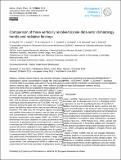Comparison of three vertically resolved ozone data sets: climatology, trends and radiative forcings
Author(s)
Hassler, Birgit; Young, P. J.; Portmann, R. W.; Bodeker, G. E.; Daniel, J. S.; Rosenlof, K. H.; Solomon, Susan; ... Show more Show less
DownloadHassler-2013-Comparison of three.pdf (3.647Mb)
PUBLISHER_CC
Publisher with Creative Commons License
Creative Commons Attribution
Terms of use
Metadata
Show full item recordAbstract
Climate models that do not simulate changes in stratospheric ozone concentrations require the prescription of ozone fields to accurately calculate UV fluxes and stratospheric heating rates. In this study, three different global ozone time series that are available for this purpose are compared: the data set of Randel and Wu (2007) (RW07), Cionni et al. (2011) (SPARC), and Bodeker et al. (2013) (BDBP). All three data sets represent multiple-linear regression fits to vertically resolved ozone observations, resulting in a spatially and temporally continuous stratospheric ozone field covering at least the period from 1979 to 2005. The main differences among the data sets result from regression models, which use different observations and include different basis functions. The data sets are compared against ozonesonde and satellite observations to assess how the data sets represent concentrations, trends and interannual variability. In the Southern Hemisphere polar region, RW07 and SPARC underestimate the ozone depletion in spring ozonesonde measurements. A piecewise linear trend regression is performed to estimate the 1979–1996 ozone decrease globally, covering a period of extreme depletion in most regions. BDBP overestimates Arctic and tropical ozone depletion over this period relative to the available measurements, whereas the depletion is underestimated in RW07 and SPARC. While the three data sets yield ozone concentrations that are within a range of different observations, there is a large spread in their respective ozone trends. One consequence of this is differences of almost a factor of four in the calculated stratospheric ozone radiative forcing between the data sets (RW07: −0.038 Wm[superscript −2], SPARC: −0.033 Wm[superscript −2], BDBP: −0.119 Wm[superscript −2]), important in assessing the contribution of stratospheric ozone depletion to the total anthropogenic radiative forcing.
Date issued
2013-06Department
Massachusetts Institute of Technology. Department of Chemistry; Massachusetts Institute of Technology. Department of Earth, Atmospheric, and Planetary SciencesJournal
Atmospheric Chemistry and Physics
Publisher
Copernicus GmbH
Citation
Hassler, B., P. J. Young, R. W. Portmann, G. E. Bodeker, J. S. Daniel, K. H. Rosenlof, and S. Solomon. “Comparison of three vertically resolved ozone data sets: climatology, trends and radiative forcings.” Atmospheric Chemistry and Physics 13, no. 11 (June 6, 2013): 5533-5550.
Version: Final published version
ISSN
1680-7324
1680-7316